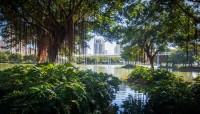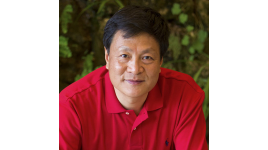Landscape Information
Situated west of the Linchun River, roughly four miles upstream of its confluence with the South China Sea, this approximately 168-acre park is surrounded by roads and high-rise structures. The park was designed by Turenscape in 2015 and deploys Kongjian Yu’s “sponge city” concept, transforming a channelized wetland, filled with debris and overgrown with invasive vegetation, to a flood resilient landscape.
The park features a Y-shaped central lake, connected to Linchun River by a channel. The steep, northeastern portion of the lakeshore is stabilized with terraces that slow down and catch storm water runoff. Much of the lake’s edge is dominated by dikes and ponds of different depths, inspired by ancient cut-and-fill techniques developed in the nation’s Pearl River Delta region. The ponds remediate storm water, provide critical wildlife habitat, and promote visitor enjoyment. A network of paths and boardwalks originate at the park’s southwest entrance, which includes visitor amenities and a plaza. The paths are shaded by canopy trees and navigate the dikes, inviting visitors to the water’s edge. Beyond the ponds, the lake is populated with richly vegetated, mounded islands that each feature an individual banyan tree. An elevated walkway, supported by evenly spaced metal poles, invite pedestrians to walk along and above the water feature and banyan canopy. The walkway, unified by its material and color palette, features multiple sections that each follow different alignments, terminating at a distinct perforated tower on the western side of the lake. The contrasting white structure, with its biomorphically-shaped apertures, serves both as an orienting focal point and observatory. The tower affords visitors near and distinct views of the park and urban skyline beyond.













